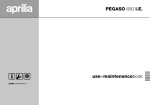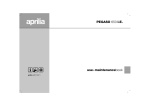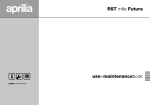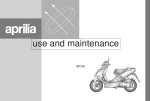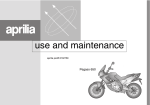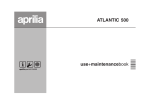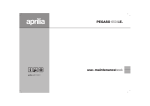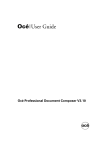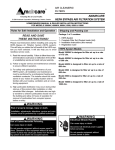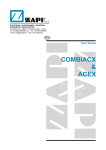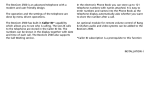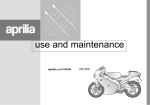Download APRILIA ETV 1000 CAPONORD Technical data
Transcript
ETV mille Caponord use+maintenancebook aprilia part# 8104310 © 2001 aprilia s.p.a. - Noale (VE) 3!&%49 7!2.).'3 The following precautionary warnings are used throughout this manual in order to convey the following messages: warning. When you find this aSafety symbol on the vehicle or in the manual, be careful to the potential risk of personal injury. Non-compliance with the indications given in the messages preceded by this symbol may result in grave risks for your and other people’s safety and for the vehicle! First edition: february 2001 Reprint: aWARNING Indicates a potential hazard which may result in serious injury or even death. aCAUTION Produced and printed by: editing division Soave (VERONA) - Italy Tel. +39 - 045 76 11 911 Fax +39 - 045 76 12 241 E-mail: [email protected] www.stp.it On behalf of: aprilia s.p.a. via G. Galilei, 1 - 30033 Noale (VE) - Italy Tel. +39 - 041 58 29 111 Fax +39 - 041 44 10 54 www.aprilia.com 2 use and maintenance ETV mille Caponord Indicates a potential hazard which may result in minor personal injury or damage to the vehicle. NOTE The word “NOTE” in this manual precedes important information or instructions. 4%#(.)#!, ).&/2-!4)/. ( The operations preceded by this symbol must be repeated also on the opposite side of the vehicle. If not expressly indicated otherwise, for the reassembly of the units repeat the disassembly operations in reverse order. The terms “right” and “left” are referred to the rider seated on the vehicle in the normal riding position. 7!2.).'3 02%#!54)/.3 '%.%2!, !$6)#% Before starting the engine, carefully read this manual and in particular the section “SAFE DRIVE”. Your and other people’s safety depends not only on your quickness of reflexes and on your agility, but also on what you know about the vehicle, on its efficiency and on your knowledge of the basic information for “SAFE DRIVE”. Therefore, get a thorough knowledge of the vehicle, in such a way as to be able to drive in the traffic safely. NOTE Keep a stock of one bulb per type with the vehicle (see technical data). NOTE This manual must be considered as an integral part of the vehicle and must always accompany it, even in case of resale. aprilia has carried out this manual with the maximum attention, in order to supply the user with correct and updated information. However, since aprilia constantly improves the design of its products, there may be slight discrepancies between the characteristics of your vehicle and those described in this manual. For any clarification concerning the information contained in this manual, do not hesitate to contact your aprilia Official Dealer. For control and repair operations not expressly described in this publication, for the purchase of aprilia genuine spare parts, accessories and other products, as well as for specific advice, contact exclusively aprilia Official Dealers and Service Centers, which guarantee prompt and accurate assistance. Thank you for choosing aprilia. We wish you a nice ride. All rights as to electronic storage, reproduction and total or partial adaptation, with any means, are reserved for all Countries. NOTE In some countries the antipollution and noise regulations in force require periodical inspections. The user of the vehicle in these countries must: – contact an aprilia Official Dealer to have the non-homologated components replaced with others homologated for use in the country in question; – carry out the required periodical inspections. NOTE Soon after purchasing the vehicle, write down the identification data indicated on the SPARE PARTS IDENTIFICATION LABEL in the table here below. This label is positioned on the frame, under the saddle; to read it, it is necessary to remove the saddle, see p. 78 (REMOVING THE RIDER SADDLE). These data indicate: – YEAR = year of manufacture (Y, 1, 2, ...); – I.M. = modification code (A, B, C, ...); – COUNTRY CODES = homologation country (I, UK, A, ...). In this manual the various versions are indicated by the following symbols: e automatic light switching version (Automatic Switch-on Device) m optional o catalytic version VERSION: I Italy S Singapore U s Slovenia United Kingdom a Austria i Israel p ¬ South Korea Portugal F Finland M Malaysia B Belgium c Chile d Germany H Croatia f A Australia France E Spain u United States of G Ä Brazil Greece America O Holland R South Africa Y Switzerland n New Zealand D Denmark C Canada J Japan and are to be supplied to the aprilia Official Dealer as reference data for the purchase of spare parts or specific accessories of the model you have acquired. use and maintenance ETV mille Caponord 3 4!",% /& #/.4%.43 SAFE DRIVE BASIC SAFETY RULES ...................................... 6 CLOTHING .......................................................... 9 ACCESSORIES ................................................. 10 LOAD ................................................................. 10 ARRANGEMENT OF THE MAIN ELEMENTS ....... 12 ARRANGEMENT OF THE INSTRUMENTS/CONTROLS .................................. 14 INSTRUMENTS AND INDICATORS ....................... 15 INSTRUMENTS AND INDICATORS TABLE ..... 16 SETTING BUTTONS ......................................... 20 MAIN INDEPENDENT CONTROLS ........................ 22 CONTROLS ON THE LEFT PART OF THE HANDLEBAR ..................................................... 22 CONTROLS ON THE RIGHT PART OF THE HANDLEBAR ..................................................... 23 IGNITION SWITCH ............................................ 24 STEERING LOCK .............................................. 25 PARKING LIGHTS ............................................. 25 AUXILIARY EQUIPMENT ....................................... 26 UNLOCKING/LOCKING THE PASSENGER SEAT .......................................... 26 UNLOCKING/LOCKING THE GLOVE/TOOL KIT COMPARTMENT COVER ................................. 26 GLOVE/TOOL KIT COMPARTMENT ................ 27 SPECIAL TOOLS m ........................................ 28 OUTLET ............................................................. 28 ACCESSORIES ................................................. 28 MAIN COMPONENTS ............................................. 29 FUEL .................................................................. 29 BRAKE FLUID - recommendations .................... 30 DISC BRAKES ................................................... 31 FRONT BRAKE ................................................. 32 REAR BRAKE .................................................... 34 CLUTCH FLUID - recommendations ................. 35 CLUTCH ............................................................ 36 COOLANT .......................................................... 38 TYRES ............................................................... 40 ENGINE OIL ...................................................... 41 ADJUSTING THE FRONT BRAKE CONTROL LEVER AND THE CLUTCH CONTROL LEVER 42 4 use and maintenance ETV mille Caponord ADJUSTING THE REAR BRAKE CONTROL LEVER CLEARANCE ....................................... AUTOMATIC LIGHT SWITCHING VERSION e .................................................... CATALYTIC SILENCER o ............................. EXHAUST SILENCER/EXHAUST TERMINAL . INSTRUCTIONS FOR USE .................................... GETTING ON AND OFF THE VEHICLE .......... PRELIMINARY CHECKING OPERATIONS ..... PRELIMINARY CHECKING OPERATIONS ..... STARTING ........................................................ DEPARTURE AND DRIVE ............................... RUNNING-IN ..................................................... STOPPING ........................................................ PARKING .......................................................... POSITIONING THE VEHICLE ON THE STAND SUGGESTIONS TO PREVENT THEFT ........... MAINTENANCE ..................................................... REGULAR SERVICE INTERVALS CHART ...... IDENTIFICATION DATA ................................... CHECKING THE ENGINE OIL LEVEL AND TOPPING UP .................................................... CHANGING THE ENGINE OIL AND THE OIL FILTER .............................................................. AIR CLEANER .................................................. FRONT WHEEL ................................................ FRONT BRAKE CALIPERS .............................. REAR WHEEL .................................................. POSITIONING THE VEHICLE ON THE FRONT SUPPORT STAND m ..................................... REMOVING THE OIL SUMP GUARD .............. REMOVE THE LEFT FAIRING ......................... REMOVAL OF THE FUEL TANK ...................... REMOVING THE FUSE BOX COVER ............. REMOVING THE RIDER SADDLE ................... REAR-VIEW MIRRORS .................................... DRIVE CHAIN ................................................... CHECKING THE STEERING ............................ CHECKING THE REAR FORK FULCRUM AXIS ............................................... INSPECTING THE FRONT AND REAR SUSPENSIONS ................................................ 42 43 43 43 44 44 46 47 48 51 54 55 55 56 58 58 60 62 63 64 66 68 70 71 74 75 75 76 78 78 79 80 82 82 83 FRONT SUSPENSION ..................................... 83 REAR SUSPENSION ........................................ 84 CHECKING THE BRAKE PAD WEAR .............. 86 IDLING ADJUSTMENT ..................................... 87 ADJUSTING THE ACCELERATOR CONTROL ......................................................... 87 CHECKING THE STAND .................................. 88 SPARK PLUGS ................................................. 90 BATTERY .......................................................... 92 CHECKING AND CLEANING THE TERMINALS ...................................................... 92 REMOVING THE BATTERY ............................. 93 CHECKING THE ELECTROLYTE LEVEL ........ 93 RECHARGING THE BATTERY ........................ 94 INSTALLING THE BATTERY ............................ 94 LONG INACTIVITY OF THE BATTERY ............ 95 CHECKING THE SWITCHES ........................... 95 AIR TEMPERATURE SENSOR CONTROL ..... 95 CHANGING THE FUSES .................................. 96 HORIZONTAL ADJUSTMENT OF THE HEADLIGHT BEAM ........................................... 98 ADJUSTING THE VERTICAL HEADLIGHT BEAM ................................................................ 98 DASHBOARD LIGHTING .................................. 99 BULBS ............................................................... 99 CHANGING THE HEADLIGHT BULBS .......... 100 CHANGING THE FRONT DIRECTION INDICATOR BULBS ........................................ 101 CHANGING THE REAR DIRECTION INDICATOR BULBS ........................................ 102 CHANGING THE REAR LIGHT BULB ............ 102 CHANGING THE NUMBER PLATE BULB ............................................................... 103 TRANSPORT ........................................................ 104 CLEANING ........................................................... 104 LONG PERIODS OF INACTIVITY .................. 106 TECHNICAL DATA .............................................. 107 LUBRICANT CHART ....................................... 110 Importers .................................................. 112-113 WIRING DIAGRAM - ETV mille Caponord ...... 114 safe drive "!3)# 3!&%49 25,%3 To drive the vehicle it is necessary to be in possession of all the requirements prescribed by law (driving licence, minimum age, psychophysical ability, insurance, state taxes, vehicle registration, number plate, etc.). Gradually get to know the vehicle by driving it first in areas with low traffic and/or private areas. 6 use and maintenance ETV mille Caponord The use of medicins, alcohol and drugs or psychotropic substances notably increases the risk of accidents. Be sure that you are in good psychophysical conditions and fit for driving and pay particular attention to physical weariness and drowsiness. Most road accidents are caused by the driver’s lack of experience. NEVER lend the vehicle to beginners and, in any case, make sure that the driver has all the requirements for driving. Rigorously observe all road signs and national and local road regulations. Avoid abrupt movements that can be dangerous for yourself and other people (for example: rearing up on the back wheel, speeding, etc.), and give due consideration to the road surface, visibility and other driving conditions. Avoid obstacles that could damage the vehicle or make you lose control. Avoid riding in the slipstream created by preceding vehicles in order to increase your speed. Always drive with both hands on the handlebars and both feet on the footrests (or on the rider’s footboards), in the correct driving posture. Avoid standing up or stretching your limbs while driving. use and maintenance ETV mille Caponord 7 OIL The driver should pay attention and avoid distractions caused by people, things and movements (never smoke, eat, drink, read, etc.) while driving. 8 use and maintenance ETV mille Caponord COOLER Use only the vehicle’s specific fuels and lubricants indicated in the “LUBRICANT CHART”; check all oil, fuel and coolant levels regularly. If the vehicle has been involved in an accident, make sure that no damage has occurred to the control levers, pipes, wires, braking system and vital parts. If necessary, have the vehicle inspected by an aprilia Official Dealer who should carefully check the frame, handlebars, suspensions, safety parts and all the devices that you cannot check by yourself. Always remember to report any malfunction to the technicians to help them in their work. Never use the vehicle when the amount of damage it has suffered endangers your safety. ONLY ORIGINALS A12 345 Never change the position, inclination or colour of: number plate, direction indicators, lights and horns. Any modification of the vehicle will result in the invalidity of the guarantee. Any modification of the vehicle and/or the removal of original components can compromise vehicle performance levels and safety or even make it illegal. We recommend respecting all regulations and national and local provisions regarding the equipment of the vehicle. In particular, avoid all modifications that increase the vehicle’s performance levels or alter its original characteristics. Never race with other vehicles. Avoid off-road driving. #,/4().' Before starting, always wear a correctly fastened crash helmet. Make sure that it is homologated, in good shape, of the right size and that the visor is clean. Wear protective clothing, preferably in light and/or reflecting colours. In this way you will make yourself more visible to the other drivers, thus notably reducing the risk of being knocked down, and you will be more protected in case of fall. This clothing should be very tight-fitting and fastened at the wrists and ankles; strings, belts and ties should not be hanging loose; prevent these and other objects from interfering with driving by getting entangled with moving parts or driving mechanisms. use and maintenance ETV mille Caponord 9 Do not keep objects that can be dangerous in case of fall, for example pointed objects like keys, pens, glass vials etc. in your pockets (the same recommendations also apply to passengers). 10 use and maintenance ETV mille Caponord !##%33/2)%3 The owner of the vehicle is responsible for the choice, installation and use of any accessory. Avoid installing accessories that cover horns or lights or that could impair their functions, limit the suspension stroke and the steering angle, hamper the operation of the controls and reduce the distance from the ground and the angle of inclination in turns. Avoid using accessories that hamper access to the controls, since this can prolong reaction times during an emergency. Big fairings and windshields installed on the vehicle may produce aerodynamic forces that affect the stability of the vehicle, especially when riding at high speed. Make sure that the equipment is well fastened to the vehicle and not dangerous during driving. Do not install electrical devices and do not modify those already existing to avoid electrical overloads, because the vehicle could suddenly stop or there could be a dangerous current shortage in the horn and in the lights. aprilia recommends the use of genuine accessories (aprilia genuine accessories). ,/!$ Be careful and moderate when loading your luggage. Keep any luggage loaded as close as possible to the center of gravity of the vehicle and distribute the load uniformly on both sides, in order to reduce umbalance to the minimum. Furthermore, make sure that the load is firmly secured to the vehicle, especially during long trips. KG! Avoid hanging bulky, heavy and/or dangerous objects on the handlebars, mudguards and forks, because the vehicle might respond more slowly in turns and its manoeuvrability could be unavoidably impaired. Do not place bags that are too bulky on the vehicle sides and do not ride with the crash helmet, because they could hit people or obstacles, making you lose control of the vehicle. Do not carry any bag if it is not tightly secured to the vehicle. Do not carry bags which protrude too much from the luggage-rack or which cover the lights, horn or indicators. Do not carry animals or children on the glove compartment or on the luggage rack. Do not exceed the maximum load allowed for each side-bag. When the vehicle is overloaded, its stability and its manoeuvrability can be compromised. use and maintenance ETV mille Caponord 11 !22!.'%-%.4 /& 4(% -!). %,%-%.43 +%9 1) 2) 3) 4) Headlight Left rear-view mirror Clutch fluid reservoir Ignition switch/steering lock/parking lights 5) Engine oil tank cap 12 use and maintenance ETV mille Caponord 6) 7) 8) 9) 10) 11) Saddle lock Rider left footrest Rider saddle Battery Passenger seat Electronic unit 12) Rear fork 13) Drive chain 14) Passenger left footrest (snapping, closed/open) 15) Centre stand m 16) Side stand 17) 18) 19) 20) 21) 22) Shifting lever Engine oil filter Engine oil tank Engine oil level Horn Left fairing +%9 1) 2) 3) 4) 5) Rear light Glove/tool kit compartment Main fuse carrier (30A) Rear shock absorber Fuel tank 6) 7) 8) 9) 10) Air cleaner Fuel tank filler cap Front brake fluid tank Right rear-view mirror Secondary fuse carrier (15A) 11) 12) 13) 14) 15) 16) Air temperature sensor Coolant expansion tank cap Coolant expansion Rear brake control lever Rider right footrest Rear brake pump 17) Rear brake fluid tank 18) Passenger right footrest (snapping, closed/open) use and maintenance ETV mille Caponord 13 !22!.'%-%.4 /& 4(% ).3425-%.43#/.42/,3 6 5 4 3 2 1 0 140160 120 180 100 200 Km/h 80 220 60 240 260 40 280 20 0 Km 7 7 8 6 A 9 10 11 12 T AIR min-1 x1000 L gal SERVICE 8 C F TIME EFI MODE SET ENGINE CONTROL DIAGNOSIS 9 1 5 10 4 3 2 12 11 +%9 Ignition switch/steering lock/parking lights (2 - 1 - & - :) Direction indicator switch (6) Horn push button (*) Dimmer switch (8 - 7) High beam signaller push button (7)/LAP push button (multifunction) 6) Clutch lever 1) 2) 3) 4) 5) 14 use and maintenance ETV mille Caponord 7) 8) 9) 10) 11) 12) Instruments and indicators Front brake lever Throttle grip Engine stop switch (2 - 1) Start push button (+) Light switch (( - ' - •) (not provided for e) ).3425-%.43 !.$ ).$)#!4/23 4 3 5 EFI 2 1 4 5 6 3 100 80 200 40 8 8 10 T AIR min -1 1 0 180 km/h 60 7 9 2 120 140 160 7 6 x1000 MAGNETI MARELLI SERVICE 220 0 C F 240 20 km 11 12 TIME EFI MODE ENGINE SET CONTROL DIAGNOSIS 10 9 +%9 1) 2) 3) 4) 5) 6) 7) Speedometer Green direction indicator warning light LED (6) Red engine oil pressure warning light LED (.) Amber side stand down warning light LED (Æ) Red diagnostic warning light LED (EFI) Blue high beam warning light LED (7) Amber low fuel warning light LED (-) 8) Right multifunction digital display (fuel level-air temperature coolant temperature - clock/injection system error codes) 9) SET and MODE programming buttons 10) Green neutral indicator warning light LED (/) 11) Revolution counter 12) Left digital display (odometer) use and maintenance ETV mille Caponord 15 ).3425-%.43 !.$ ).$)#!4/23 4!",% aCAUTION The switching km/mi °C/°F is set and fixed by APRILIA in the vehicle production phase, according to the country of destination. This setting cannot be modified successively. Description Direction indicator warning light LED High beam warning light LED Revolution counter rpm NOTE Whenever the ignition switch is turned to position “2”, all the LED warning lights, including the dashboard lighting LEDs, come on on the dashboard for approximately three seconds, thus testing the correct operation of the LEDs. Function 6 Blinks when the direction indicators are on. 7 Comes on when the high beam bulbs are on or when the headlight signaller is operated. Indicates the number of revolutions of the engine per minute. Never exceed the engine max. speed rate, see p. 54 (RUNNING-IN). aCAUTION Amber low fuel warning light LED Comes on when the quantity of fuel left in the tank is about 4 ± 1 L. In this case, top up as soon as possible, see p. 29 (FUEL). Side stand down war warning light LED Æ Comes on when the side stand is down. Engine oil pressure warning light LED Neutral indicator warning light LED Comes on whenever the ignition switch is in position “2” and the engine is not running, thus checking the functionality of the LED. If the light LED does not come on in this phase, contact an aprilia Official Dealer. . If the engine oil pressure warning light LED “.” remains on after aCAUTION the start or comes on during the normal operation of the engine, this means that the engine oil pressure in the circuit is insufficient. In this case, stop the engine immediately and contact an APRILIA Official Dealer. / Comes on when the gear is in neutral. Follow ã 16 use and maintenance ETV mille Caponord Follow ã Description Diagnostic warning light LED Function Comes on for approximately three seconds whenever the ignition switch is turned to position “2”, thus testing the correct operation of the LED. If the diagnostic warning light LED “EFI” comes on and blinks aCAUTION EFI when the engine is started or starts blinking during the normal operation of the engine, this means that the electronic unit has detected an anomaly. In many cases, the engine keeps running with reduced performance levels; immediately contact an APRILIA Official Dealer. Speedometer (km/h) It indicates the driving speed. Digital display Odometer (km - mi) (left side) Indicates the partial or total number of kilometres (miles) covered. Multifunction digital display Fuel level indicator (right side) Indicates the fuel level in the tank. The fuel quantity is shown by the indicator range (analog display). When the fuel tank is full, the indicator range is completely on. As the fuel level decreases, the marked area of the indicator range decreases accordingly. When no segment of the indicator range is on and the low fuel warning light - LED blinks, this means that the quantity of fuel left in the tank amounts to less than 5 ± 1 L. In this case, top up as soon as possible, see p. 29 (FUEL). When no segment of the indicator range is on, the aCAUTION numerical display blinks indicating “” and the low fuel warning light LED blinks, contact an APRILIA Official Dealer. NOTE The digital sector is used to display the air temperature (T°AIR). To alternate the data displayed, see p. 20 (SETTING BUTTONS). Follow ã use and maintenance ETV mille Caponord 17 Follow ã Multifunction Air temperature digital display indicator (right side) Displays the air temperature. This temperature is displayed in the numerical sector (numerical display). With temperatures under -20 °C (-4 °F) the writing “” is displayed; between -20 °C (-68 °F) and 50 °C (122 °F) the exact temperature value is displayed; over 50 °C (122 °F) the writing “” (“”) is displayed. the digital display blinks indicating a tempeaWARNING When rature equal to or lower than 3°C (37.4 °F), drive at moderate speed, since there may be ice formation, and avoid abrupt T°AIR brakings or manoeuvres that may cause loss of grip. When the air temperature is equal to or lower than 3 °C (37.4 °F), the display blinks indicating the temperature for ten seconds [even if in the meantime the temperature increases and exceeds 3 °C (37.4 °F)]. If the temperature remains under 3 °C (37.4 °F), the procedure is repeated every five minutes for three times. When the digital display blinks showing the writing aCAUTION “BB” or the writing “”, contact an APRILIA Official Dealer. To alternate the data displayed, see p. 20 (SETTING BUTTONS). Follow ã 18 use and maintenance ETV mille Caponord Follow ã Indicates the temperature of the coolant in the engine, see p. 20 (SETTING BUTTONS). The temperature is indicated by the indicator range (analog display) and by the value expressed in °C (°F) (digital display). Up to 35 °C (97 °F) the writing “” is displayed. aCAUTION The switching on and off of the cooling fans does not depend on the position of the ignition switch. To lower the coolant temperature the cooling fans operate even when the engine is not running and are switched off automatically. Coolant temperature indicator (°C/°F) ) aCAUTION If the maximum allowed temperature (125°C or 257 °F) is exceeded, the engine may be seriou- sly damaged. If a temperature of 116 – 125 °C (241 – 257 °F) is displayed and the secondlast segment of the indicator range blinks, stop the engine, wait for the cooling fans to be switched off and check the coolant level, see p. 38 (COOLANT). If a temperature of 126 – 135 °C (259 – 275 °F) is displayed and the last two segments of the indicator range blink, stop the vehicle and let the engine idle for approximately two minutes, thus allowing the coolant to circulate regularly in the system; then, press the engine stop switch to position “1” and check the coolant level, see p. 38 (COOLANT). If the situation on the dashboard remains the same after the coolant level has been checked, do not start the vehicle and contact an aprilia Official Dealer. Multifunction digital display (right side) Service operation indicator “SERVICE” After the first 1000 km (625 mi) and successively every 7500 km (4600 mi), the word “SERVICE” appears. In this case contact an APRILIA Official Dealer, aCAUTION who will carry out the operations indicated in the regular service intervals chart, see p. 60 (REGULAR SERVICE INTERVALS CHART). Clock Indicates the hour and minutes according to the presetting, see p. 20 (SETTING BUTTONS). To alternate the data displayed, see p. 20 (SETTING BUTTONS). use and maintenance ETV mille Caponord 19 2 4 EFI 5 1 T AIR 4 5 6 3 100 PU SH 80 180 km/h 60 200 40 1 0 8 8 6 9 2 120 140 160 7 10 C T AIR min -1 x1000 9 MAGNETI MARELLI 220 0 ENGINE SET CONTROL DIAGNOSIS C 240 20 TIME EFI MODE km TIME ENGINE MODE 3 3%44).' "544/.3 aWARNING The operations described below must be carried out with the vehicle at rest. Performing these operations while the vehicle is running may be cause of accidents. NOTE The following information is to be considered as referred to the vehicle at rest. When the ignition key (1) is turned to position “2”, the following lights come on on the dashboard within three seconds: – all the warning lights LED; – all the dashboard lighting LEDs; – all the segments on the left display; – all the segments and writings on the right multifunction display; – the pointers of the indicators move to the bottom of the indicator range; thus testing the operation of LEDs, writings, segments and instruments. 20 use and maintenance ETV mille Caponord SET CONTROL DIAGNOSIS 7 After three seconds, the engine oil pressure warning light LED “.” (2) remains on on the dashboard (and will remain on until the engine is started) and the following will appear on the displays: – total number of kilometres covered (3); – fuel quantity (4); – air temperature (5); – coolant temperature (6) [up to 35 °C (95°F) the writing “---” is displayed]; – hour and minutes (7). ADJUSTING THE DASHBOARD LIGHTING It is possible to select three different levels for the dashboard lighting: 100%; 60%; 25%. For the adjustment, proceed as follows: U Move the light switch (8) to position “'”; ì Bring the dimmer switch “8 - 7” (9) to position “8”. 10 NOTE Three seconds after the last selection, the button SET returns to the switching mode total/partial kilometres (miles) odometer. U Turn the ignition switch (1) to position “2” and, within three seconds, press the button SET (10) in sequence, thus obtaining the three lighting levels. U Select the desired lighting level. SWITCHING FROM km/mi, °C/°F aCAUTION The switching km/mi, °C/°F is set and fixed by APRILIA in the vehicle production phase, according to the country of destination. This setting cannot be modified successively. T AIR 4 5 6 3 L 7 5 4 9 2 1 0 T AIR 8 km/h C 10 C km TIME ENGINE TIME MODE ENGINE MODE 2 SET SET CONTROL DIAGNOSIS CONTROL DIAGNOSIS 1 3 1 SWITCHING FROM TOTAL TO PARTIAL KILOMETRE (MILE) ODOMETER Left display U Press and release the button SET (1); the relevant total partial or total kilometres (miles) covered will appear on the display. SETTING THE CLOCK (HOURS AND MINUTES) U To confirm the minute setting, press and NOTE NOTE NOTE NOTE Whenever the ignition switch is turned to position “2”, the display always indicates the total number of kilometres (miles) covered. To set the partial kilometre (mile) odometer to zero, proceed as follows: U Display the partial number of kilometres covered, see above. U Press the button SET (1) for more than three seconds; the segments (2) are set to zero. The setting of the clock can be carried out only with the vehicle at rest. release the MODE (3) push button. If the battery is removed, the clock is set to zero. U Press the MODE (3) push button for more than three seconds, the segments corresponding to the hours (4) will blink. If the button SET (1) is pressed and released, the data are changed one by one; if the button SET (1) is kept pressed, the data change scrolling quickly and cyclically. U Press the SET (1) push button and se- lect the desired hour. U To confirm the time setting, press and re- lease the button MODE (3), and the minute segments (5) will blink. U Press the SET (1) push button and select the desired minutes. use and maintenance ETV mille Caponord 21 -!). ).$%0%.$%.4 #/.42/,3 4 #/.42/,3 /. 4(% ,%&4 0!24 /& 4(% (!.$,%"!2 NOTE The electrical parts work only when the ignition switch is in position “2”. 3 1) HORN PUSH BUTTON (*) The horn is activated when the push button is pressed. 2 1 2) DIRECTION INDICATOR SWITCH (6) To indicate the turn to the left, move the switch to the left; to indicate the turn to the right, move the switch to the right. To turn off the direction indicator, press the switch. 3) DIMMER SWITCH (8 - 7) When the light switch is in position “(”: if the dimmer switch is in position “7”, the high beam comes on; while if it is in position “8”, the low beam comes on. 3) DIMMER SWITCH (8 - 7) e When it is in position “8” the parking lights, the dashboard light and the low beam are always on. When it is in position “7”, the high beam comes on. 4) HIGH BEAM SIGNALLING PUSH BUTTON (7) It makes it possible to use the high beam for signalling to forthcoming vehicles while overtaking and in case of peril and/or emergency. The high beam blinking is operated by pressing the push button, independently of the position of the light switch (( - ' - •). NOTE button. 22 use and maintenance ETV mille Caponord To disconnect the high beam blinking, release the push #/.42/,3 /. 4(% 2)'(4 0!24 /& 4(% (!.$,%"!2 1 NOTE The electrical parts work only when the ignition switch is in position “2”. A PU SH 1) ENGINE STOP SWITCH (2 - 1) aWARNING Do not operate the engine stop switch “2 - 1” in running conditions. This is a safety or emergency switch. With the switch pressed in position “2”, it is possible to start the engine; when the switch is pressed to position “1”, the engine stops. aCAUTION To stop the vehicle, use exclusively the ignition switch (A). Leave the engine stop switch (1) in position “2” and use it only in case of emergency. aCAUTION 2 3 3) START PUSH BUTTON (+) When the start push button “+” is pressed, the starter makes the engine run. For the starting, see p. 48 (STARTING). With stopped engine and ignition switch in position “2”, the battery may discharge. If the engine stop switch must be used (1), immediately afterwards turn the ignition switch (A) to position “1”. 2) LIGHT SWITCH (( - ' - •) (not provided for e) When the light switch is in position “•”, the lights are off; when the switch is in position “'”, the parking lights and the dashboard light are on; when the switch is in position “(”, the parking lights, the dashboard light and the low beam are on. The high beam can be operated by means of the dimmer switch. use and maintenance ETV mille Caponord 23 Position 1 Steering lock 2 3 The ignition switch (1) is positioned on the upper plate of the steering column. Two keys are supplied together with the vehicle (one spare key). NOTE Do not keep the spare key on the vehicle. 24 use and maintenance ETV mille Caponord It is possible The steering is loc- to remove the key. ked. It is neither possible to start the engine, nor to switch on the lights. The engine It is not possiand the ble to remove lights can be the key. switched on. PU SH The key operates the ignition switch/steering lock, the fuel tank lock (2) and the passenger seat lock (3). Key removal Neither the It is possible engine, nor to remove the the lights key. can be switched on. )'.)4)/. 37)4#( NOTE Function The parking It is possible lights are to remove the on. key. Z AD I 1 34%%2).' ,/#+ aWARNING Never turn the key to position “&” in running conditions, in order to avoid losing control of the vehicle. OPERATION To lock the steering: U Turn the handlebar completely leftwards. U Turn the key to position “1”. U Press the key and rotate it to position “&”. NOTE If it is necessary to switch on the parking lights, see p. 25 (PARKING LIGHTS). U Extract the key. PU SH 1 PU SH 1 0!2+).' ,)'(43 The vehicle is provided with front and rear parking lights. Even if it is always advisable to park the vehicle in the appropriate parking areas and in any case in illuminated places, the parking lights are very useful when it is necessary to park the vehicle in a dark or badly illuminated area, or in any case when the vehicle must be visible. aCAUTION Do not leave the parking lights on for long periods, in order to avoid the wear of the battery due to the current consumption required by the lights. The complete wear of the battery makes it impossible to start the vehicle. OPERATION To switch on the parking lights, proceed as follows: U Lock the steering without extracting the key (1), see p. 25 (STEERING LOCK). U Turn the key (1) to position “:” (PARK- ING). U Make sure that both parking lights (front and rear) are on and operate correctly. U Remove the key (1). use and maintenance ETV mille Caponord 25 !58),)!29 %15)0-%.4 5.,/#+).',/#+).' 4(% 0!33%.'%2 3%!4 U Position the vehicle on the stand, see p. 56 (POSITIONING THE VEHICLE ON THE STAND). U Introduce the key (1) in the seat lock. U Rotate the key (1) clockwise, lift and withdraw the seat (2) from behind. NOTE To lock the seat (2), proceed as follows: NOTE Before lowering and locking the seat (2), make sure that you have not left the key in the glove/tool kit compartment. U Insert the two front couplings (4) in the relevant seats (5). U Lower and press the passenger seat (2), making the lock snap. The glove/tool kit compartment is positioned under the passenger seat. aWARNING To reach it, proceed as follows: U Remove the glove/tool kit compartment cover (3). Before leaving, make sure that the seat (2) is properly locked. 26 use and maintenance ETV mille Caponord 5.,/#+).',/#+).' 4(% ',/6%4//, +)4 #/-0!24-%.4 #/6%2 If a larger surface for the luggage is needed, when the rider travels alone the passenger seat can be removed. To carry out this operation, it is necessary to lock the glove/tool kit compartment cover (3). In this case: U Remove the passenger seat, see p. 26 (UNLOCKING/LOCKING THE PASSENGER SEAT). U Remove the lock coupling (6) from its seat. U Insert the lock coupling (6) and fit it correctly in the appropriate seat (7) on the glove/tool kit compartment cover (see figure). U Correctly position the glove/tool kit compartment cover (3) in its seat. 10 6 11 9 7 14 6 12 15 13 U Lower and press the glove/tool kit com- partment cover (3), making the lock snap. Maximum allowed weight: 9 kg. aWARNING The luggage must not be excessively bulky and it must be firmly anchored to the passenger grab rails. ',/6%4//, +)4 #/-0!24-%.4 To reach the glove/tool kit compartment, proceed as follows: U Remove the saddle, see p. 26 (UNLOCKI N G / L O C KI NG T HE PA SS E NG ER SEAT). The tool kit (8) includes: – 2.5 – 3 – 4 – 5 – 6 mm bent hexagon spanners (9); – 8 – 10 mm double fork spanner (10); – 13 – 14 mm double fork spanner (11); – 26 mm simple box spanner (12); – extension for simple box spanners (13); – 6 – 7 mm double socket spanner (14); – 8 – 10 mm double socket spanner (15); – 16 mm socket spanner for spark plug (16); – double-ended, cross-/cut-headed screwdriver (17); – tool case (18); 16 18 17 Maximum allowed weight: 1.5 kg. use and maintenance ETV mille Caponord 27 1 30%#)!, 4//,3 m To perform some specific operations, it is advisable to use the following special tools (to be requested to an aprilia Official Dealer): Tool 2 Operations Front support stand (1), see p. Front wheel di74 (POSITIONING THE VEHI- sassembly. CLE ON THE FRONT SUPPORT STAND m). /54,%4 This vehicle is provided with an outlet (2) for plugs with 20 mm diameter. Do not connect any electrical equipment with electrical input over 180 W or voltage different from 12 V to the outlet. aWARNING Do not use the outlet while the vehicle is running, since the plug may come off and fall on the moving parts of the vehicle. !##%33/2)%3 The vehicle may be equipped with the following accessories (to be requested to the aprilia Official Dealer): – centre stand m; – side bags m; – bag on the tank m; – rear case m. 28 use and maintenance ETV mille Caponord -!). #/-0/.%.43 &5%, aWARNING The fuel used for internal combustion engines is extremely inflammable and in particular conditions it can become explosive. It is important to carry out the refuelling and the maintenance operations in a well-ventilated area, with the engine off. Do not smoke while refuelling or near fuel vapours, in any case avoid any contact with naked flames, sparks and any other heat source to prevent the fuel from catching fire or from exploding. Further, prevent fuel from flowing out of the fuel filler, as it could catch fire when getting in contact with the red-hot surfaces of the engine. In case some fuel has accidentally been spilt, make sure that the area has completely dried and before starting the vehicle verify that there is no fuel inside the fuel filler neck. Since petrol expands under the heat of the sun and due to the effects of sun radiation, never fill the tank to the brim. Screw the plug up carefully after refuelling. Avoid any contact of the fuel with the skin and the inhalation of vapours; do not swallow fuel or pour it from a receptacle into another by means of a tube. DO NOT DISPOSE OF FUEL IN THE ENVIRONMENT. KEEP AWAY FROM CHILDREN. Use only premium grade unleaded petrol, min. O.N. 95 (N.O.R.M.) and 85 (N.O.M.M.). To refuel, proceed as follows: U Raise the flap (1). U Insert the key (2) in the tank plug lock (3). U Turn the key clockwise, pull and open the fuel flap. FUEL TANK CAPACITY (reserve included): 25 L TANK RESERVE: 5 ± 1 L aCAUTION Do not put additives or other substances into the fuel. If you use a funnel or other similar items, make sure that they are perfectly clean. aWARNING 1 MAX MAX 3 2 After refuelling: NOTE The cap can be closed only when the key (2) is inserted. U With inserted key (2), close the cap by pressing it. aWARNING Make sure that the cap is properly closed. U Withdraw the key (2). U Close the flap (1). Do not fill the tank completely; the maximum fuel level must remain below the lower edge of the filler neck (see figure). U Refuel. use and maintenance ETV mille Caponord 29 NOTE This vehicle is provided with front and rear disc brakes, with separate hydraulic circuits. aWARNING aWARNING Make sure that the brake discs are neither oily nor greasy, especially after maintenance or checking operations. The following information refers to a single braking system, but is valid for both. Check that the brake cables are neither twisted nor worn out. Carefully wash the parts of your body that get in contact with the liquid. Consult a doctor or an oculist if the liquid gets in contact with your eyes. aWARNING Prevent water or dust from accidentally getting into the circuit. "2!+% &,5)$ RECOMMENDATIONS Sudden resistance or clearance problems on the brake lever may be due to troubles in the hydraulic system. For any doubt regarding the perfect functioning of the braking system and in case you are not able to carry out the usual checking operations, contact your APRILIA Official Dealer. 30 use and maintenance ETV mille Caponord In case maintenance operations are to be performed on the hydraulic circuit, it is advisable to use latex gloves. If the brake fluid gets in contact with the skin or the eyes, it can cause serious irritations. DO NOT DISPOSE OF THE FLUID IN THE ENVIRONMENT. KEEP AWAY FROM CHILDREN. aCAUTION When using the brake fluid, take care not to spill it on the plastic or painted parts, since it can damage them. $)3# "2!+%3 aWARNING The brakes are the parts that most ensure your safety and for this reason they must always be perfectly working; check them before every trip. A dirty disc soils the pads, with consequent reduction of the braking efficiency. Dirty pads must be replaced, while dirty discs must be cleaned with a high-quality degreaser. The brake fluid must be changed every two years by an APRILIA Official Dealer. Use brake fluid of the type specified in the lubricant chart, see p. 110 (LUBRICANT CHART). NOTE NOTE The front braking system is with double disc (right and left side). The rear braking system is with single disc (right side). The following information refers to a single braking system, but is valid for both. When the disc pads wear out, the level of the fluid decreases to automatically compensate for their wear. The front brake reservoir is positioned on the right part of the handlebar, near the front brake lever coupling. Have the brake discs checked by an aprilia Official Dealer after the first 1000 km (625mi) and successively every 7500 km (4687 mi). Before departure, check the brake fluid level in the reservoirs, see p. 32 (FRONT BRAKE), p. 34 (REAR BRAKE), and the wear of the pads, see p. 86 (CHECKING THE BRAKE PAD WEAR). Have the brake fluid changed every two years by an aprilia Official Dealer. This vehicle is provided with disc brakes with two, front and rear braking systems having separate hydraulic circuits. The rear brake reservoir is positioned on the right side of the vehicle, near the rear brake control lever. Perform the maintenance operations with doubled frequency if the vehicle is used in rainy or dusty areas, on uneven surfaces or on racetracks. aWARNING Do not use the vehicle if the braking system leaks fluid. use and maintenance ETV mille Caponord 31 3 2 2 1 5 MIN 4 1 &2/.4 "2!+% CHECK U Position the vehicle on the stand, see p. 56 (POSITIONING THE VEHICLE ON THE STAND). U Turn the handlebar partially rightwards, so that the fluid contained in the brake fluid tank is parallel to the edge of the brake fluid tank (1) (see figure). U Make sure that the fluid level exceeds the “MIN” mark. MIN= minimum level If the fluid does not reach at least the “MIN” mark: aCAUTION When the disc pads wear out, the level of the fluid decreases progressively to compensate for their wear. 32 use and maintenance ETV mille Caponord U Check the brake pad wear, see p. 86 U Unscrew the two screws (2) of the brake (CHECKING THE BRAKE PAD WEAR) and the disc wear. reservoir (1) by means of a short, crossheaded screwdriver. If the pads and/or the disc do not need replacing, provide for topping up. TOPPING UP Carefully read p. 30 (BRAKE FLUID recommendations). aCAUTION The brake fluid may flow out of the tank. Do not operate the front brake lever if the screws (2) are loose or, most important, if the brake fluid tank cover has been removed. aCAUTION Position a cloth under the brake reservoir, in case some fluid should be spilled. aWARNING Avoid any prolonged exposure of the brake fluid to the air. The brake fluid is hygroscopic and when in contact with the air it absorbs its humidity. Leave the brake fluid tank open ONLY for the time necessary for topping up. U Raise and remove the cover (3) together with the screws (2). U Remove the guide cover (4). U Remove the gasket (5). 5 - 6 mm 6 1 aCAUTION aCAUTION In order not to spill the brake fluid while topping up, do not shake the vehicle. Do not put additives or other subtances into the fluid. If you use a funnel or other similar items, make sure that they are perfectly clean. Do not exceed the “MAX” level while topping up. It is advisable to top up until reaching the “MAX” level only with new pads. Do not reach the “MAX” level with worn out pads, since this will cause a fluid outflow when the pads are changed. NOTE As a reference mark corresponding to the maximum level “MAX”, use the notch (6) stamped inside the brake fluid tank (1) and top up until reaching it. U Put back the gasket (5) in its seat cor- rectly. U Put back the guide cover (4) correctly. U Put back the cover (3). U Screw and tighten the screws (2). aWARNING Check the braking efficiency. In case of excessive stroke of the brake lever or reduced efficiency of the braking system, contact an APRILIA Official Dealer, since it may be necessary to bleed the system. NOTE If no notch (6) is available, top up leaving a space of 5 – 6 mm from the edge of the brake fluid tank (1). U Top up the reservoir (1) by adding brake fluid, see p. 110 (LUBRICANT CHART), until reaching the correct level. use and maintenance ETV mille Caponord 33 aCAUTION 2 4 MIN 2 MIN 5 3 1 2%!2 "2!+% CHECK U Keep the vehicle in vertical position, so that the fluid contained in the tank (1) is parallel to the plug (2). U Make sure that the fluid level exceeds the “MIN” mark. MIN= minimum level MAX= maximum level If the fluid does not reach at least the “MIN” mark: aCAUTION When the disc pads wear out, the level of the fluid decreases progressively to compensate for their wear. U Check the brake pad wear, see p. 86 (CHECKING THE BRAKE PAD WEAR) and the disc wear. If the pads and/or the disc do not need replacing, provide for topping up. 34 use and maintenance ETV mille Caponord 1 TOPPING UP Carefully read p. 30 (BRAKE FLUID recommendations). aCAUTION The brake fluid may flow out of the tank. Do not operate the rear brake lever if the brake fluid tank plug is loose or has been removed. aWARNING Avoid any prolonged exposure of the brake fluid to the air. The brake fluid is hygroscopic and when in contact with the air it absorbs its humidity. Leave the brake fluid tank open ONLY for the time necessary for topping up. U Unscrew and remove the screw (3), tak- ing the nut. U Remove the clip (4). U Unscrew and remove the plug (2). In order not to spill the brake fluid while topping up, keep the fluid in the tank parallel to the tank rim (in horizontal position). Do not put additives or other subtances into the fluid. If you use a funnel or other similar items, make sure that they are perfectly clean. U Remove the gasket (5). U Top up the reservoir (1) by adding brake fluid, see p. 110 (LUBRICANT CHART), until reaching the correct level included between the “MIN” and “MAX” marks”. aCAUTION It is advisable to top up until reaching the “MAX” level only with new pads. Do not reach the “MAX” level with worn out pads, since this will cause a fluid outflow when the pads are changed. Check the braking efficiency. In case of excessive stroke of the brake lever or reduced efficiency of the braking system, contact an APRILIA Official Dealer, since it may be necessary to bleed the system. aCAUTION Make sure that the cable is neither twisted nor worn out. Prevent water or dust from accidentally getting into the circuit. In case maintenance operations are to be performed on the hydraulic circuit, it is advisable to use latex gloves. #,54#( &,5)$ RECOMMENDATIONS NOTE This vehicle is provided with hydraulic clutch control. aCAUTION Sudden resistance or clearance problems on the clutch lever may be due to troubles in the hydraulic system. For any doubt regarding the perfect functioning of the system and in case you are not able to carry out the usual checking operations, contact your APRILIA Official Dealer. If the fluid gets in contact with the skin or the eyes, it can cause serious irritations. Carefully wash the parts of your body that get in contact with the liquid. Consult a doctor or an oculist if the liquid gets in contact with your eyes. DO NOT DISPOSE OF THE FLUID IN THE ENVIRONMENT. KEEP AWAY FROM CHILDREN. When using the fluid, take care not to spill it on the plastic and painted parts, since it damages them. The clutch control fluid must be changed every two years by an APRILIA Official Dealer. Use fluid of the type specified in the lubricant chart, see p. 110 (LUBRICANT CHART). The clutch fluid reservoir is positioned on the left part of the handlebar, near the clutch control lever coupling. NOTE Perform the maintenance operations with doubled frequency if the vehicle is used in rainy or dusty areas, on uneven surfaces or on racetracks. Before departure, check the fluid level in the tank, see p. 36 (CLUTCH); have it changed by an aprilia Official Dealer every two years. aWARNING Do not use the vehicle if you notice fluid leakages from the clutch control system. use and maintenance ETV mille Caponord 35 2 1 MIN 2 #,54#( NOTE Perform the maintenance operations with doubled frequency if the vehicle is used in rainy or dusty areas, on uneven surfaces or on racetracks. Have the clutch checked by an aprilia Official Dealer every 7500 km (4687 mi). NOTE The engine is provided with an hydraulic control clutch, aided by the PPC (Pneumatic Power Clutch) exclusive patented system, which avoids the bouncing of the rear wheel. CHECK U Position the vehicle on the stand, see p. 56 (POSITIONING THE VEHICLE ON THE STAND). U Turn the handlebar partially rightwards, so that the fluid contained in the clutch fluid tank is parallel to the edge of the clutch fluid tank (1) (see figure). U Make sure that the fluid level exceeds the “MIN” mark. MIN= minimum level U If the fluid does not reach the “MIN” mark, provide for topping up. TOPPING UP Carefully read p. 35 (CLUTCH FLUID recommendations). aCAUTION The fluid may flow out. Do not operate the clutch control lever if the reservoir plug is loose or has been removed. aWARNING Avoid any prolonged exposure of the clutch fluid to the air. The clutch fluid is hygroscopic and when in contact with the air it absorbs its humidity. Leave the clutch fluid tank open ONLY for the time necessary for topping up. aCAUTION Position a cloth under the brake reservoir, in case some fluid should be spilled. U Using a short, cross-tip screwdriver, un- screw the two screws (2) of the clutch fluid tank (1). 36 use and maintenance ETV mille Caponord 3 2 4 2 1 5 aCAUTION Do not shake the vehicle, in order not to spill fluid while topping up. Do not put additives or other subtances into the fluid. If you use a funnel or other similar items, make sure that they are perfectly clean. U Raise and remove the cover (3) together with the screws (2). U Remove the gasket (4). NOTE In order to reach the “MAX” level, top up until covering the glass (5) completely, with the clutch fluid reservoir rim parallel to the ground. aCAUTION Do not exceed the “MAX” level while topping up. U Put back the gasket (4) in its seat cor- rectly. U Put back the cover (3). U Screw and tighten the screws (2). aWARNING Check the clutch efficiency. If the stroke of the clutch control lever is excessive or if the clutch system is not efficient, contact your APRILIA Official Dealer, since it may be necessary to bleed the system. U Top up the reservoir (1) by adding clutch fluid, see p. 110 (LUBRICANT CHART), until reaching the correct level. use and maintenance ETV mille Caponord 37 #//,!.4 aCAUTION 1 Do not use the vehicle if the coolant is below the minimum prescribed level (LOW). NOTE Perform the maintenance operations with doubled frequency if the vehicle is used in rainy or dusty areas, on uneven surfaces or on racetracks. Before departure, check the coolant level, see p. 39 (CHECKING AND TOPPING UP); have the coolant changed every two years: for this operation, contact an aprilia Official Dealer. aWARNING The coolant is noxious: do not swallow it; if the coolant gets in contact with the skin or the eyes, it can cause serious irritations. If the fluid gets in contact with your skin or eyes, rinse with plenty of water and consult a doctor. If it is swallowed, induce vomit, rinse mouth and throat with plenty of water and consult a doctor without delay. KEEP AWAY FROM CHILDREN. DO NOT DISPOSE OF THE FLUID IN THE ENVIRONMENT. Be careful not to spill the coolant on the red-hot parts of the engine: it may catch fire and send out invisible flames. 38 use and maintenance ETV mille Caponord In case any maintenance operation should be required, it is advisable to use latex gloves. aCAUTION Have the pads changed by your APRILIA Official Dealer. The coolant is composed of 50% water and 50% antifreeze. This mixture is ideal for most running temperatures and ensures good protection against corrosion. It is advisable to keep the same mixture also in the hot season, since in this way losses due to evaporation are reduced and it is not necessary to top up very frequently. The mineral salt deposits left in the radiator by evaporated water are thus reduced and the efficiency of the cooling system remains unchanged. If the outdoor temperature is below 0°, check the cooling circuit frequently and if necessary increase the antifreeze concentration (up to maximum 60%). For the cooling solution use distilled water, in order not to damage the engine. aWARNING Do not remove the expansion tank plug (1) when the engine is hot, since the coolant is under pressure and its temperature is high. If it gets in contact with the skin or with clothes it may cause severe burns and/or damage. 2 1 1 FULL LOW CHECKING AND TOPPING UP aWARNING Check the coolant level and top up the expansion tank with cold engine. U Stop the engine and wait until it has cooled down. U Keep the vehicle in vertical position, with the two wheels resting on the ground. U Make sure that the coolant contained in the expansion tank (2) is included between the “FULL” and “LOW” marks, by checking through the appropriate slot on the right fairing”. FULL = maximum level LOW = minimum level If not, proceed as follows: U Top up the expansion tank by adding U Unscrew and remove the filling cap (1). coolan t, se e p. 11 0 (LUBRICANT CHART), until this almost reaches the “FULL” level. Do not exceed this level, otherwise the fluid will flow out while the engine is running. U Put back the filling cap (1). aWARNING The coolant is noxious: do not swallow it; if the coolant gets in contact with the skin or the eyes, it can cause serious irritations. Do not use your fingers or any other object to check if there is enough coolant. aCAUTION Do not put additives or other subtances into the fluid. If you use a funnel or other similar items, make sure that they are perfectly clean. aCAUTION In case of excessive consumption of coolant and in case the tank remains empty, make sure that there are no leaks in the circuit. Have it repaired by an APRILIA Official Dealer. use and maintenance ETV mille Caponord 39 492%3 After repairing a tyre, have the wheels balanced. This vehicle is provided with tubeless tyres. aWARNING NOTE Perform the maintenance operations with doubled frequency if the vehicle is used in rainy or dusty areas, on uneven surfaces or on racetracks. aWARNING 1 Check the inflation pressure at room temperature every two weeks. Check the conditions of the tyres and the inflation pressure at room temperature every 1000 km (625 mi), see p. 107 (TECHNICAL DATA). aWARNING Periodically check the tyre inflation pressure at room temperature, see p. 107 (TECHNICAL DATA). If the tyres are hot, the measurement is not correct. Carry out the measurement especially before and after long rides. If the inflation pressure is too high, the ground unevenness cannot be dampened and is therefore transmitted to the handlebar, thus compromising the driving comfort and reducing the road holding during turns. If, on the contrary, the inflation pressure is too low, the tyre sides (1) are under greater stress and the tyre itself may slip on the rim or it may become loose, with consequent loss of control of the vehicle. 40 use and maintenance ETV mille Caponord In case of sudden braking the tyres could even come off the rims. Further, the vehicle could skid while turning. aWARNING Check the surface and the wear of the tyres, since tyres in bad conditions can impair both the grip and the controllability of the vehicle. Some types of tyres homologated for this vehicle are provided with wear indicators. There are several kinds of wear indicators. For more information on how to check the wear, contact your Dealer. Visually check if the tyres are worn and in this case have them changed. Change the tyre when it is worn out or in case of puncture on the tread side, if the puncture is larger than 5 mm. The tyres must be replaced with other tyres of the type and model recommended by the manufacturer, see p. 107 (TECHNICAL DATA); the use of tyres different from those prescribed may adversely affect the manoeuvrability of the vehicle. Do not install tyres with air tube on rims for tubeless tyres and viceversa. Make sure that the inflation valves (2) always have their sealing caps on, to prevent the tyres from suddenly going flat. Change, repair, maintenance and balancing operations are very important and therefore they must be performed by qualified technicians with appropriate tools. aWARNING For this reason, it is advisable to have the above mentioned operations carried out by an APRILIA Official Dealer or by a qualified tyre repairer. If the tyres are new, they may still be covered with a slippery film: drive carefully for the first miles. Do not oil the tyres with unsuitable fluids. If the tyres are old, even if not completely worn out, they may become hard and may not ensure good road holding. In this case, replace them. %.').% /), aWARNING Engine oil may cause serious damage to the skin if handled daily and for long periods. Wash your hands carefully after use. 3 KEEP AWAY FROM CHILDREN. 2 MINIMUM TREAD DEPTH LIMIT (3): front and rear 2 mm and in any case not less than prescribed by the regulations in force in the country where the vehicle is used. aCAUTION Be particularly careful when installing/removing the tyres, in order to avoid scratching or damaging the rims with the vice. DO NOT DISPOSE OF THE OIL IN THE ENVIRONMENT. Put it in a sealed container and take it to the filling station where you usually buy it or to an oil salvage center. In case any maintenance operation should be required, it is advisable to use latex gloves. aCAUTION If the engine oil pressure warning light LED “.” comes on during the normal operation of the engine, this means that the engine oil pressure in the circuit is insufficient. In this case, check the engine oil level, see p. 63 (CHECKING THE ENGINE OIL LEVEL AND TOPPING UP); if the level isn’t correct, stop the engine immediately and contact an APRILIA Official Dealer. aCAUTION Proceed with care. Do not spill the oil! Take care not to smear any component, the area in which you are working and the surrounding area. Carefully remove any trace of oil. In case of leakages or malfunctions, contact an APRILIA Official Dealer. Periodically check the engine oil level, see p. 63 (CHECKING THE ENGINE OIL LEVEL AND TOPPING UP). For the engine oil change, see p. 60 (REGULAR SERVICE INTERVALS CHART) and p. 64 (CHANGING THE ENGINE OIL AND THE OIL FILTER). NOTE Use high-quality 15W – 50 oil, see p. 110 (LUBRICANT CHART). use and maintenance ETV mille Caponord 41 3 2 3 1 1 4 7 1 8 5 6 4m m 2 3 4 4 2 !$*534).' 4(% &2/.4 "2!+% #/.42/, ,%6%2 !.$ 4(% #,54#( #/.42/, ,%6%2 It is possible to adjust the distance between the lever (1) end and the grip (2), by rotating the adjuster (3). The positions “1” and “4” correspond to an approximate distance of 105 and 85 mm, respectively, between the lever end and the grip. The positions “2” and “3” correspond to intermediate distances. ~Push the control lever (1) forward and rotate the adjuster (3) until the desired number is positioned in correspondence with the reference arrow. 42 use and maintenance ETV mille Caponord !$*534).' 4(% 2%!2 "2!+% #/.42/, ,%6%2 #,%!2!.#% The brake control lever is positioned ergonomically during the assembly of the vehicle. If necessary, it is possible to adjust the brake control lever clearance: U Loosen the lock nut (4). U Screw the brake adjuster (5) completely. U Screw the lock nut (6) completely on the pump control rod (7). U Screw the pump control rod (7) completely, then unscrew it by giving 3 – 4 turns. U Screw the brake adjuster (5) until the brake pedal reaches the desired height. U Lock the brake adjuster (5) by means of the lock nut (4). U Unscrew the pump control rod (7) and bring it in contact with the pump piston. U Screw the rod in order to ensure a minimum clearance of 0.5 – 1 mm between the pump control rod (7) and the pump piston. aCAUTION Make sure that there is a certain idle stroke in the movement of the lever (8), to prevent the brake from remaining applied and the consequent untimely wear of the braking elements. Lever (8) idle stroke: 4 mm (measured at the lever end). U Lock the pump control rod (7) by means of the lock nut (6). aCAUTION After the adjustment, make sure that the wheel rotates freely with released brake. Check the braking efficiency. If necessary, contact your APRILIA Official Dealer. aCAUTION PU SH Do not use leaded petrol, since it causes the destruction of the catalytic converter. %8(!534 3),%.#%2%8(!534 4%2-).!, aWARNING Tampering with the noise control system is prohibited. !54/-!4)# ,)'(4 37)4#().' 6%23)/. e The vehicles provided with this device can be immediately recognized, since the lights come automatically on as soon as the ignition switch is turned to position “2”. For this reason, no light switch is provided. The lights can be switched off only by turning the ignition switch to position “1”. Before starting the vehicle, make sure that the dimmer switch is in position “8” (front low beam). #!4!,94)# 3),%.#%2 o aWARNING Avoid parking the vehicle catalytic version near dry brush wood or in places easily accessible to children, as the catalytic silencer becomes extremely hot during use; be very careful and avoid any kind of contact before it has completely cooled down. The catalytic vehicle is fitted with a silencer with metal catalytic converter of the “platinum-rhodium bivalent” type. This device provides for the oxidation of the CO (carbon monoxide) and of the HC (unburned hydrocarbons) contained in the exhaust gases, changing them into carbon dioxide and steam, respectively. Owners are warned that the law may prohibit: – the removal or rendering inoperative by any person, other than for purposes of maintenance, repair or replacement, of any device or element of design incorporated into any new vehicle – for the purpose of noise control – prior to its sale or delivery to the ultimate purchaser or while it is in use; – the use of the vehicle after such device or element of design has been removed or rendered inoperative by any person. Check the exhaust silencer and the silencer pipes, making sure that there are neither signs of rust, nor holes and that the exhaust system works effectively. If the noise produced by the exhaust system increases, immediately contact your aprilia Official Dealer. use and maintenance ETV mille Caponord 43











































